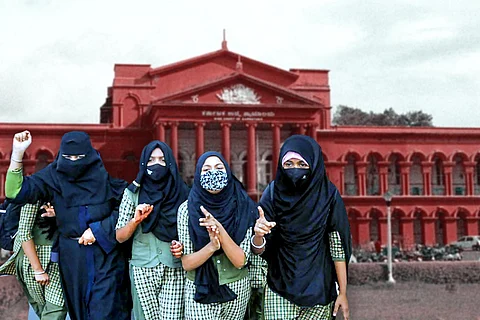

The government PU college in Udupi, which is at the centre of the hijab row in Karnataka, on Wednesday, February 23, told the Karnataka High Court that the Campus Front of India ‘instigated’ six students to start wearing a hijab to class. Senior advocate SS Naganand, representing the Government PU College for Girls in Udupi, the principal as well as a teacher, told the High Court bench comprising Chief Justice Ritu Raj Awasthi, Justice JM Khazi and Justice Krishna S Dixit, that a uniform dress code was present in college since 2004 and the hijab row was started by some students who owe allegiance to CFI. He added that in their Aadhaar card photographs, the student petitioners are not wearing hijab, and contested that hijab is not an essential religious practice.
“The Campus Front of India, which seems to be a radical type of organisation, approached the college authorities and insisted that the girls wear hijab. When refused, they started behaving rashly and started protesting. Then the Muslim girl students refused to attend classes without wearing hijab,” Naganand submitted. He added that the CFI has since been coordinating the protests by hijab-clad students.
“CFI is some kind of voluntary organisation that is spearheading this drum beating for hijab. It is not an educational institution nor representative of students or parents. It is some radical organisation which comes and creates this commotion,” Naganand said, opposing the students’ petition.
‘What is this CFI?” Chief Justice Awasthi then asked, to which lawyer Mohammed Tahir, appearing for a few of the petitioners, submitted that it is a student organisation like ABVP (Akhil Bharatiya Vidyarthi Parishad, the student wing of RSS). Senior advocate Naganand submitted that it is an ‘outside organisation’ that ‘created this commotion.’
The CJ then asked the government to find out more information about this organisation. “Do you have any intelligence inputs on this organisation? All of a sudden all this has erupted…” the CJ remarked.
The Advocate General added that the government has ‘some information,’ and that it will submit the information in a sealed cover.
Nanganad continued his arguments and said that the College Development Committee has prescribed a uniform, and that there was no problem for 20 years. “The Campus Front of India and other institutions have instigated children and their parents. The result is that the educational system and everyone else are suffering,” senior counsel Naganand said.
He also cited previous Supreme Court judgments to say that “my right of peaceful existence cannot be threatened by someone else's right to exercise religion.” “This is a simple issue, let children come to school without any external symbols of religion. Now a right-wing association of Hindus wants to wear saffron shawls. Tommorow, Muslim boys will want to wear skullcaps. Where is this going to end?” Naganand said.
After Naganand concluded his submissions, senior advocate S Poovayya, representing the College Development Committee (CDC), said that the right to wear a religious attire or symbol, is not freedom of expression, but can be restricted under Article 25(2) of the Constitution to maintain public order, morality and health. “Freedom of conscience under Article 25 is the right to follow a religion and not the right to manifest it by wearing a particular attire,” he added.
“Out of 100 students, five are asking to wear hijab. If, say, we allow hijab in classrooms, what about the other 95 students who don’t wear the hijab? Will they be considered a-religious? Are they not practicers of Islam?” Poovayya argued. “If I go to a temple wearing jeans and tshirt, is the essence of Hinduism lost? The attire is just a manifestation,” he said.
He added that imparting education by public instruction is a secular activity of the state. “Therefore, the interference of religion to secular education should be kept to a minimum,” he added. “Even if hijab gets considered as an essential religious practice, it has to yield in a public institution,” he added.
“I can’t allow a Hindu child to wear a religious symbol, but then disallow a Muslim child from wearing a religious symbol. Because the Muslim student is wearing a hijab, we now have a situation where Hindu students are saying they want to wear saffron scarf…where is the end to it?” Poovayya said, opposing the student’s petitions.
At the end of the hearing, the High Court issued a clarification that its interim order, restraining students from wearing any kind of religious clothing, to high schools and colleges, is applicable to campuses which have a prescribed uniform. “If there is no uniform, this does not apply. And it applies only to students,” the HC added, when informed that some teachers were also being asked to remove the hijab in some places in the state.
The court will continue hearing arguments on Thursday, at 2.30 pm.
Here’s what has happened in the previous hearings:
Note: A previous version of the article incorrectly attributed a quote (“it is a student organisation like ABVP”) to Advocate General Prabhuling Navadgi, when in fact, it was stated by lawyer Mohammed Tahir, appearing for a few of the petitioners, in court on February 23. The error was brought to our notice by the Advocate General’s office and the error was rectified immediately. The error is deeply regretted.